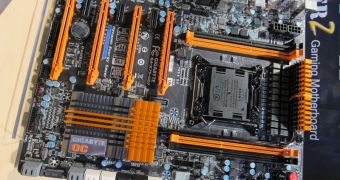The new quad-channel memory support introduced by Intel in the high-performance Sandy Bridge-E processors seems to cause quite a bit of problems to motherboard makers who are left wondering how to include support for large CPU coolers without giving up on features.
When Intel set out to develop the Sandy Bridge-E architecture, one of the most important improvements it wanted to bring with these chips was the support for higher memory bandwidths.
In order to achieve this, the chip maker settled on increasing the number of memory channels the processors can support and decided to use a quad-channel configuration.
In theory this should be able to provide 33% more bandwidth than the tri-channel memory controller used in the Nehalem core, but the addition of a fourth memory channel wasn't as easy as most of us thought.
The most important obstacle faced by Intel in its path was the need to optimize the traces on the motherboard in order to keep the latency consistent between the four DIMMs installed.
This required for all the DIMM sockets installed to be placed at about the same distance from the CPU socket, which led to a drastic redesign of the motherboard component placing.
I'm sure that by now you all have seen an X79 board and know all about the layout employed, but what most haven't found out is that this placement appears to cause all sort of problems with large CPU coolers.
Mos of these were designed to be used with motherboards having memory installed on just one side of the CPU socket, so fitting such coolers on LGA 2011 boards is quite an adventure, reports SweClockers.
Furthermore, the problem is not limited to just one motherboard manufacturer, but seems to affect pretty much all the LGA 2011 boards that were designed until now.
How big of an issue this is actually going to be is still uncertain at this point in time, as most of the info regarding Sandy Bridge-E and the LGA 2011 platform is still under NDA, but users are definitely to take a lot of care when choosing their components for such as system.
We will keep you up to date on how things evolve from this point on, although early adopters are advised to go with water cooling as this is guaranteed to cause the least amount of trouble.

 14 DAY TRIAL //
14 DAY TRIAL //